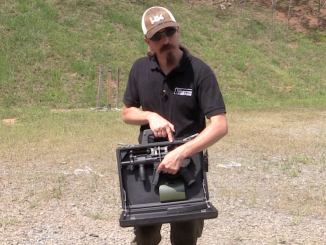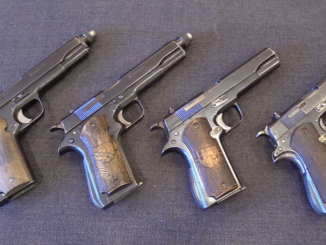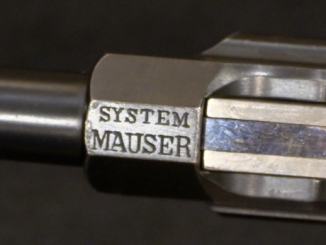The Modelo A was the first series production version of the CETME rifle, following a series of successful trials in Spain. It was developed by a team of ex-Mauser engineers led by Ludwig Vorgrimmler, and is part of the link between the late-WW2 StG45(M) and the H&K G3 rifles.
The CETME A was chambered for the reduced-power 7.62mm CETME cartridge, and had a fire control system which fired from an open bolt in full auto and a closed bolt in semiautomatic. It has a buttstock design reminiscent of the German Strumgewehr, and uses a folding bipod in lieu of a proper hand guard over the barrel. In addition, it still uses a tangent leaf rear sight, unlike the later Modelo C and G3 rifles.
There is an interesting anecdote about interdicted CETME A rifles being used by French marine commandos in Algeria…
Many thanks to Movie Armaments Group in Toronto for the opportunity to showcase their AR-10 rifles for you – check them out on Instagram to see many of the guns in their extensive collection!




Owned one once. The G3, not the Cetme A or B. Sent it off to auction at Rock Island, not a bad rifle.
Experimented with trying to fire it without oiling or lubricating in any way. Thing seized up solid in less than one mag. Would not loosen up even when I broke it down. Had to wait and disassemble again at home.
Worked fine thereafter when lubricated. Lesson learned on a “Wonder what happens…” test.
“Worked (…) when lubricated” – very important statement. Most of us know that guns typically need to be lubricated to operate by expectation. However, that by itself carries certain burden – lubricant coated parts attract dirt – which may seize them again. It is kind like Catch 22.
If you do not have proper lubricant, problems might arise in cold temperature.
Interestingly “gun lubricant” is yet another use for WD-40 https://www.wd40.com/news/in-the-news/wd-40-can-be-an-effective-maintenance-tool-for-gun-owners
Ouch!
The oil in WD40 tends to oxidise and go really gummy, really quickly.
It then attracts shite (technical term) and gums parts together (logically implicit in “gummy”) like a feckin magnet.
In a well designed gun, that might not be much of a problem.
In a shite (technical term) gun, it can be a matter of life or death.
Think of the crappy (technical term) little free floating “connector” piece in a Remington Walker trigger:
It depends on the shite (technical term) trigger weight spring to put it into position
Gummy lube, and/or debris and/or manufacturering flaws, can prevent that from happening
Gummy oil provides two of the three
Remington usually settled out of court, with silencing conditions on the settlements. They prevented the problems from becoming knowledge that could save lives.
WD40 is a product containing an oillustrated that becomes Gummy.
Want to find which other guns become unsafe with Gummy oils?
Buy a decent gun, decent ammunition and decent cleaning and lubricating products, and don’t end up like the Barbour family, who lost a child.
Seriously, use a decent gun oil.
And there are people who don’t oil their guns at all. Do I have to mention the one idiot who used a war trophy Walther P38 as a crack pipe?
I agree WD40 is a worthless lubricant for firearms. If used for any long term storage it evaporates quickly leaving said firearms to rust from changes in humidity in your home. A good quality light machine oil is best. I’ve found any lubricant in a aerosol can usually is way too light to properly protect metal from oxidation for any length of time. I’m also not a fan of the three in one CLP oils either. While they make a ok lubricant they make a lousy bore cleaner.
I use WD40 for solving dirt in bore with follow-up wipe. After that Hoppe’s or motor oil. It works for me. For most part, I prefer to keep gun without oil altogether or at minimum. I do not like sticky hands.
“worthless lubricant for firearms”
Ok, my research proven too shallow. Lesson learned: I not enough paranoic against U.S. sources and claims – hoax-makers everywhere, if I would then would find Gun Oil RZh
http://rpch.ru/en/catalog/rust-preventing-greases/gun-oil-rzh/
Interestingly biggest part (~50%) of it is топливо Т-1, which is Russian fuel for turbojet engines. Honestly, this is somewhat surprising for me, but this is at least backed by ГОСТ 9811-61.
Although it’s a solvent cleaner, not a true lubricant, the old Hoppe’s No. 9 could be used to wipe a thin coat on interior and exterior surfaces that provided both decent corrosion protection and some lubrication.
I used it on my service sidearms for years and never had a problem with corrosion or gumming. Note that I tended to fire at least 200 rounds per month on the range to maintain proficiency and in qualification, notably through the M1911A1 and various Colt double-action revolvers.
In more recent years, I’ve used the Remington Dry Lube spray with good results. The thing is, do not spray it on the weapon; that allows condensation to collect due to the cold aerosol effect. Instead, spray it on a cloth, let it sit for a few minutes in warm air until the aerosol propellant and the moisture it collects can evaporate, then apply the lube with the cloth.
And no, I’ve never use WD-40 on a firearm, and wouldn’t. The only thing worse is 3-In-1 Oil, which should be avoided like the plague.
cheers
eon
Well I would have bought her some chocolates…
Lmao!
With Frank Zappa’s “keep it greasy” playing in the background 😉
In my years of shooting trap and skeet, both informally and in competition, the most commonly encountered shotgun was Remington’s ubiquitous Model 1100 autoloader. I found it interesting how 1100 shooters used different methods to keep the guns working. Some would spray WD-40 or some other lube on the magazine tube/gas assembly until it dripped off, then reinstalled the fore end. Others swore by shooting their 1100s totally dry.
As for me, I found WD-40 just the thing to cut plastic residue in the bore after a day’s shooting (100-200 shots) on my single barrel trap guns. I used a 36-in. long rod specially made to attach to a portable electric drill, which is then secured in a vice. The oversized steel bore brush fixed on the end of the rod would really cut the crud on the inside of the shotgun barrel which had been doused with WD-40, moving the barrel back and forth around the spinning rod. Ramming a wadded paper towel down the bore with another rod left it cleaned and oiled for the next range session.
The R on the selector posibly stands for “rafaga2, Burst
Yeah, I think you are right: “ráfaga.”
The rifle in the video is actually CETME A-2, for it is chambered for 7.62×51 (so called CETME-OTAN cartridge). CETME A-1 was a first version using the CETME indigenous 7.92×40 cartridge.
While A-1 remained a test rifle, the A-2 model was adopted by the Spanish military and during the late 1950s it saw service in Infi and West (Spanish) Sahara.
Piotr
Here i let you this is a youtube video link where are mixed real documentary footage images with a 60´s spanish patriotic-propagandistic film about Sidi-ifni war where this CETME rifle model is quite present.
https://www.youtube.com/watch?v=TGIzGeqry1A